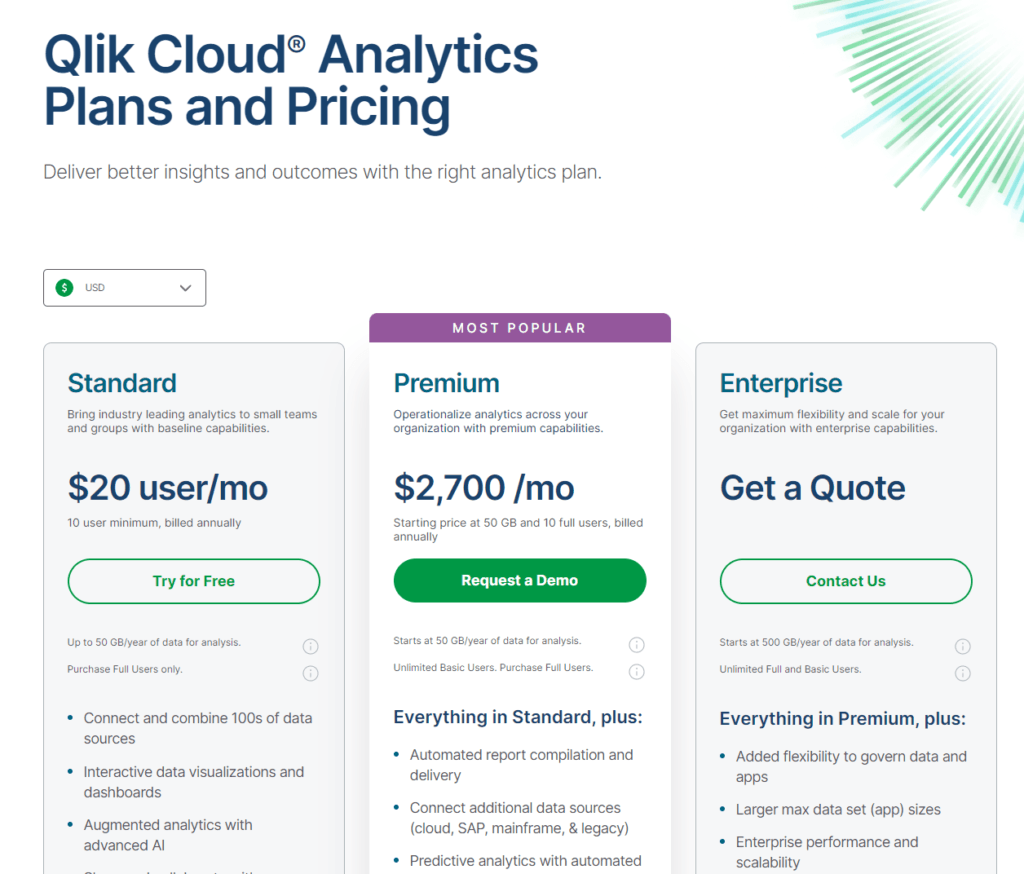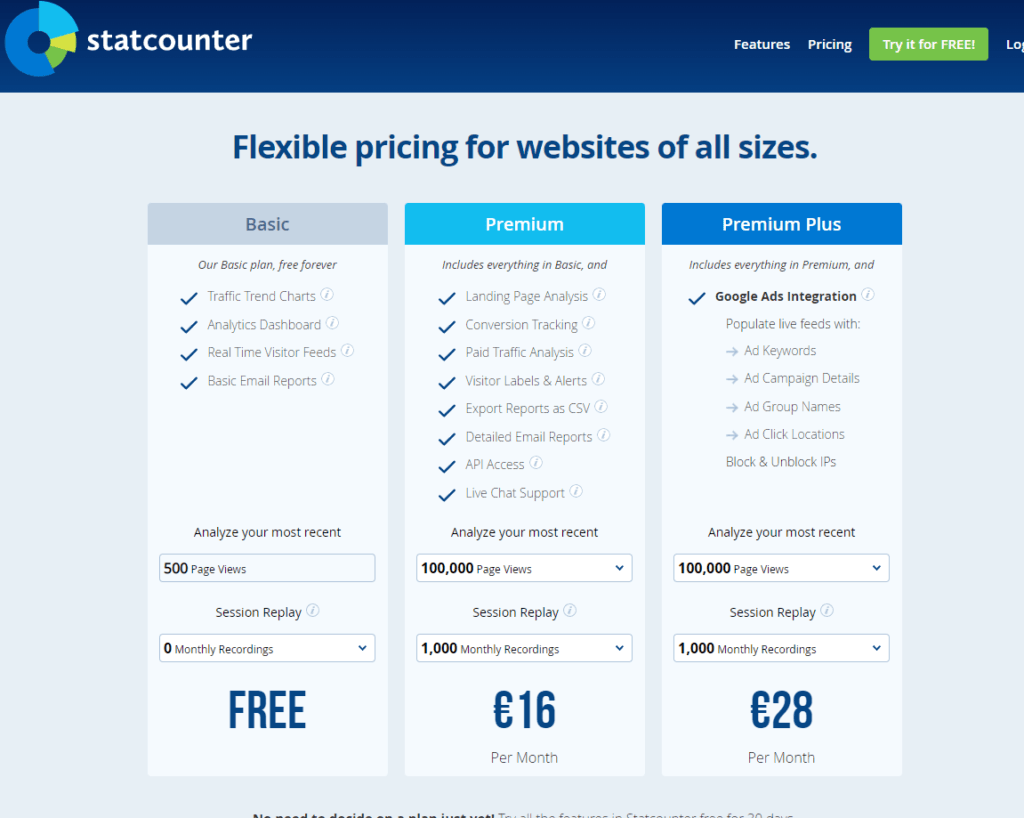In the vast and ever-expanding ocean of data analytics, where every drop of data holds the potential to unlock new insights and steer businesses towards uncharted territories of success, the choice of your analytics tool is the compass that guides your voyage. Among the myriad of stars guiding the way, two shine with particular significance: QlikView and Statcounter. Each offers a unique beacon of light for businesses looking to navigate through their data – one, a robust vessel designed for deep-sea exploration, and the other, a swift sailboat adept at catching the winds of web analytics. But which one will chart the best course for you? Whether you’re a data analyst seeking to delve into the depths of corporate data or a website owner aiming to understand the tides of your online traffic, this guide is your first mate in choosing the analytics tool that best aligns with your journey.
| QlikView | Statcounter |
|---|---|
 | |
| G2 Score -4.1 out of 5 | G2 Score -4.3 out of 5 |
| TrustRadius Score -8.0 out of 10 | TrustRadius Score -9.0 out of 10 |
Area of Comparison: User Interface and Accessibility
In the quest to harness the power of data analytics, the ease with which you can sail through an analytics tool’s interface and its accessibility to crew members of all skill levels is as crucial as the wind to a sailboat. Let’s dive into how QlikView and Statcounter fare in making the journey through data a breeze for their users.
QlikView: The Commanding Galleon
QlikView, with its comprehensive suite of analytics capabilities, is like a commanding galleon equipped with everything needed for a deep dive into data analytics. Its interface is robust and packed with advanced features, designed to satisfy the hunger for insights of the most seasoned data navigators. With QlikView, you can create complex reports, dashboards, and visualizations, offering a detailed map of your business data landscape.
However, the sophistication of QlikView’s interface comes with a steep learning curve, akin to learning the ropes of navigating a galleon. It may require time and dedication for new users to become adept at steering through its capabilities. But for those willing to master it, QlikView offers a powerful command center for data analytics, providing deep insights and a comprehensive view of your data oceans.
Statcounter: The Agile Sailboat
Statcounter, in contrast, is like an agile sailboat, designed for speed and ease of navigation through the waters of web analytics. Its interface is straightforward and user-friendly, focusing on providing website owners with clear, actionable insights into their site traffic and user behavior. Statcounter makes it easy to understand key metrics at a glance, such as visitor counts, returning visits, and page view patterns, without overwhelming you with complexity.
This simplicity makes Statcounter an excellent choice for small to medium-sized businesses, bloggers, and website owners who need a quick and accessible overview of their web analytics without diving into the deep end of data analysis. It’s the perfect tool for those looking to catch the wind of their website’s performance and steer towards success with ease.
Pricing: QlikView vs Statcounter
Embarking further into our comparative journey between QlikView and Statcounter, we reach the pivotal shores of Pricing. In the realm of data analytics, understanding the investment required not just in terms of monetary cost but also in value delivered is crucial for charting a course towards effective decision-making. Here’s how the pricing landscapes of QlikView and Statcounter compare, offering insights into which tool might best align with your budgetary expectations and analytical aspirations.
QlikView: Tailored Investment

QlikView’s pricing model reflects its position as a comprehensive, enterprise-level analytics solution, offering a tailored approach to meet the diverse needs of its users. Pricing for QlikView is not straightforward or one-size-fits-all; it’s based on a combination of factors, including the number of users, the scale of deployment, and specific feature requirements. This customization ensures that organizations can align their investment with their exact needs, but it also means that understanding the full cost can require a detailed consultation with Qlik’s sales team.
The investment in QlikView is justified by its powerful analytics capabilities, extensive data integration options, and the scalability it offers large organizations. However, for smaller businesses or those with more straightforward analytics needs, the cost can be a significant consideration. It’s important for potential users to weigh the depth and breadth of QlikView’s offerings against their specific requirements to determine if the investment aligns with the expected value.
Statcounter: Clear and Accessible

In contrast, Statcounter offers a transparent and accessible pricing model designed to cater to businesses of all sizes, particularly appealing to small and medium-sized enterprises (SMEs), bloggers, and website owners. Statcounter provides a free version with basic features that can suffice for users with minimal analytics needs. For more advanced features, such as detailed visitor insights, custom branding, and full data retention, Statcounter offers premium plans at various tiers.
The pricing tiers are clearly outlined on Statcounter’s website, making it easy for potential users to understand what they’re getting for their investment. This transparency is a breath of fresh air for businesses looking to manage their budget effectively while gaining valuable insights into their web traffic and user behavior.
Data Integration Capabilities: QlikView vs Statcounter
Continuing our journey requires adjusting our focus towards another crucial aspect that often defines the success of any analytics endeavor: Data Integration Capabilities. This facet of analytics tools is like the ability of a ship to navigate through various waters, seamlessly integrating currents from different sources to chart a clear course. Let’s examine how QlikView and Statcounter manage the essential task of integrating data from various sources, enabling organizations to navigate the vast seas of information effectively.
QlikView: The Master of Seas
QlikView stands as the master of the analytics seas when it comes to data integration capabilities. Its robust platform is designed to handle a wide array of data sources, from traditional databases and spreadsheets to cloud-based data streams and big data sources. QlikView’s powerful ETL (Extract, Transform, Load) features allow for the efficient preparation and blending of data, ensuring that users have access to harmonized and actionable information.
The platform’s associative model further enhances its integration capabilities, enabling users to explore relationships across different data sets intuitively. This allows for a comprehensive analysis that can uncover hidden insights by connecting dots across seemingly unrelated data points. For organizations that navigate through complex data landscapes, QlikView offers the capabilities needed to bring disparate data sources together in a cohesive and meaningful way.
Statcounter: The Agile Navigator
Statcounter, with its focus on web analytics, offers a more streamlined approach to data integration. It specializes in capturing and analyzing website traffic data, integrating directly with your site through a simple piece of code. This ease of integration makes Statcounter an agile navigator, quickly providing insights into visitor behavior, traffic sources, and user engagement.
While Statcounter’s data integration capabilities are primarily focused on web analytics, it excels in this domain, offering users a hassle-free setup and immediate access to key metrics. For businesses and website owners looking to gain insights into their online presence without the need for complex data preparation, Statcounter provides the necessary tools to understand and optimize their digital strategies effectively.

Related: Check out our free SEO suite

Scalability and Performance: QlikView vs Statcounter
Given our exploration so far, diving deeper into the comparison between QlikView and Statcounter, let’s turn our attention to an often pivotal aspect for businesses considering an analytics solution: Scalability and Performance. This dimension reflects how well an analytics tool can grow with your organization, accommodating increasing volumes of data and users without compromising on speed or insight quality. It’s like ensuring your vessel is not only swift but can also carry a growing crew and cargo across expanding seas. Here’s how QlikView and Statcounter stack up in these critical areas.
QlikView: The Expansive Fleet
QlikView is akin to an expansive fleet, designed to scale with your organization’s needs. Its in-memory processing ensures that data analysis is fast, allowing for quick insights even as the volume of your data grows. QlikView’s architecture is built to handle the complexities and sheer size of enterprise-level data, making it an excellent choice for organizations that anticipate significant growth or deal with large datasets.
The platform’s scalability doesn’t end with data volume; it also extends to user access. QlikView can serve a large number of users simultaneously, distributing insights across departments and ensuring that decision-making is informed by consistent, up-to-date information. This capability makes QlikView a robust choice for organizations looking to expand their analytics reach internally and foster a data-driven culture.
Statcounter: The Swift Courier
Statcounter, in contrast, operates more like a swift courier, specializing in delivering specific insights with speed and efficiency. It excels in the realm of web analytics, providing real-time data on website traffic, visitor behavior, and engagement metrics. While perhaps not as expansive as QlikView in terms of raw data processing power and scalability, Statcounter offers impressive performance for its intended use case.
Its performance is optimized for the quick delivery of web analytics insights, ensuring that marketers, website owners, and digital strategists can make timely decisions based on how users interact with their online presence. Statcounter scales well for small to medium-sized businesses and websites, ensuring that as your digital footprint grows, you continue to receive the critical insights needed to optimize your web strategies.
Customer Support and Community Engagement: QlikView vs Statcounter
Exploring further into the comparison between QlikView and Statcounter, we’ve navigated through essential considerations such as user interface and accessibility, data integration capabilities, scalability and performance, and pricing. Each of these areas provides critical insights into how each platform could serve different organizational needs. However, to round off our exploration comprehensively, it’s pertinent we touch upon Customer Support and Community Engagement—factors that significantly influence the long-term value and usability of any analytics tool.
QlikView: A Guided Expedition
QlikView offers robust customer support designed to guide users through any challenges they might encounter in their data analytics journey. With a comprehensive support system that includes technical assistance, training resources, and a vast knowledge base, QlikView ensures that organizations can maximize the utility of their platform. Additionally, QlikView boasts an active user community, Qlik Community, where users can share insights, ask questions, and learn from each other’s experiences. This vibrant community acts as an extended support network, facilitating peer-to-peer learning and problem-solving.
For enterprises that rely heavily on their analytics tools for decision-making, the level of support provided by QlikView can be a critical factor in ensuring smooth operations and continuous improvement in analytics practices. However, it’s worth noting that the most personalized levels of support may come at an additional cost, which organizations should consider when evaluating their overall investment in QlikView.
Statcounter: Streamlined Support for Swift Navigation
Statcounter, focusing on simplicity and ease of use, extends its philosophy to its customer support and community engagement efforts. The platform offers direct support through email and a detailed help center, where users can find answers to common questions and guides on leveraging Statcounter for web analytics. While the support system may seem more streamlined compared to QlikView, it aligns with Statcounter’s mission to provide a straightforward, user-friendly analytics tool.
The Statcounter forum serves as a community space where users can exchange ideas, ask for advice, and discuss best practices in web analytics. This forum, although smaller than some larger platform communities, provides a focused environment for users to connect and share specific insights related to web traffic analysis and website optimization.
Final Thoughts
Thank you for joining this comparative journey between QlikView and Statcounter. As you stand at the helm, ready to make your decision, remember that the most effective analytics tool is the one that not only addresses your current needs but also anticipates the future challenges and opportunities your organization might face. May the insights gained from this exploration light your path forward, guiding your organization to new heights of understanding, decision-making, and success in the data-driven world.
READ NEXT:
- The Role of Video Content in Financial Services SEO
- QlikView vs Segment: The Best Analytics Tool for You
- QlikView vs SAS Visual Analytics: The Best Analytics Tool for You
- Oracle Analytics Cloud vs Baremetrics: The Best Analytics Tool for You
- LLP vs Private Company in India: Which Should You Go For
- 11 Marketing Analytics Tools to Elevate Your Data-Driven Strategies
- 29+ Digital Analytics Software to Skyrocket Your Digital ROI






















Comments are closed.